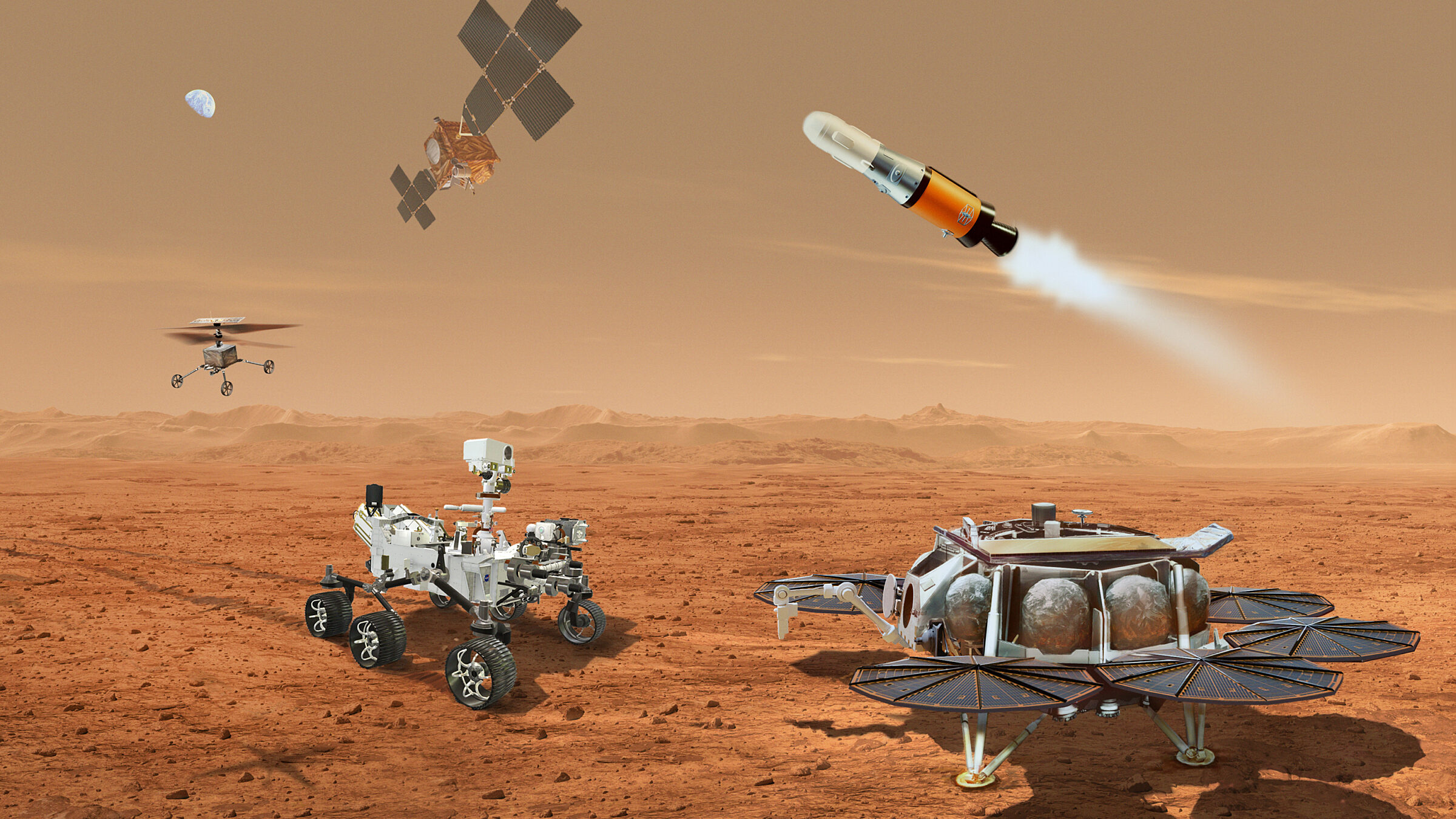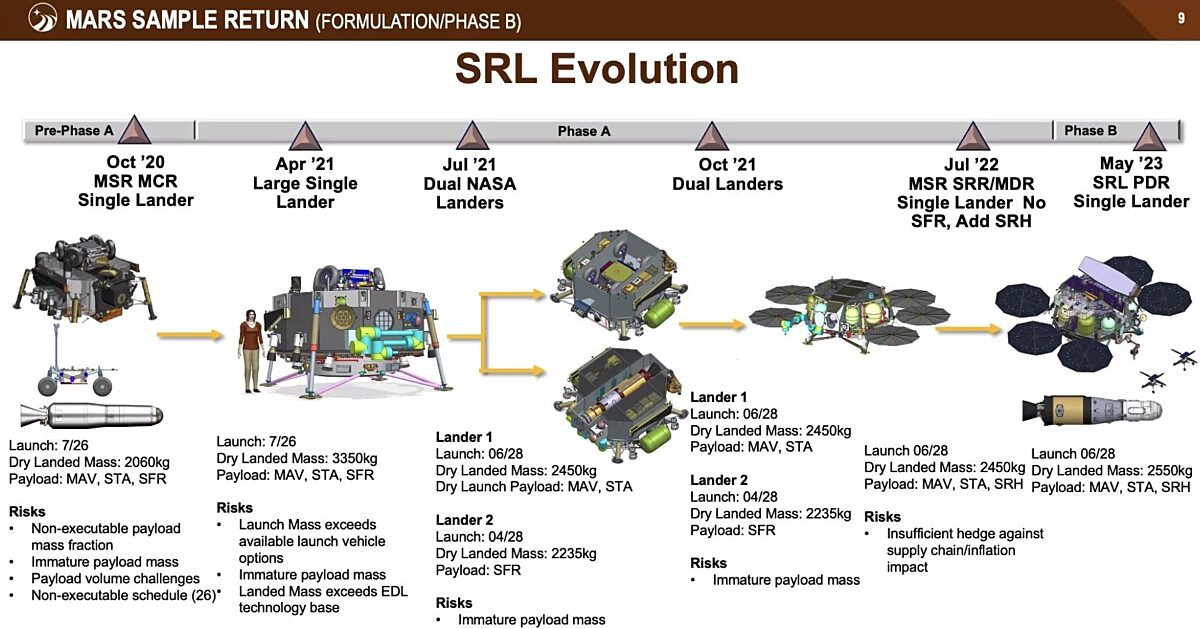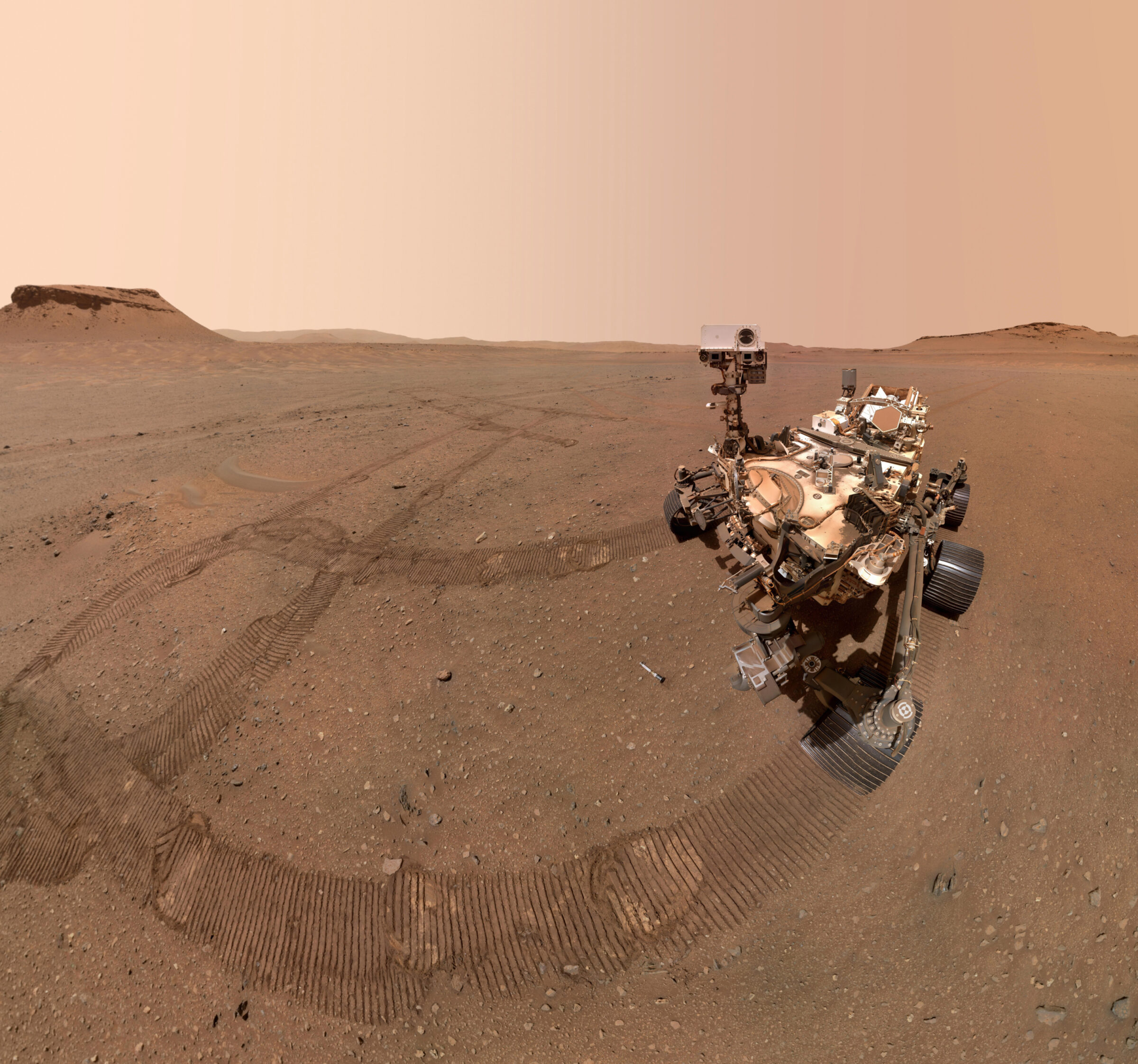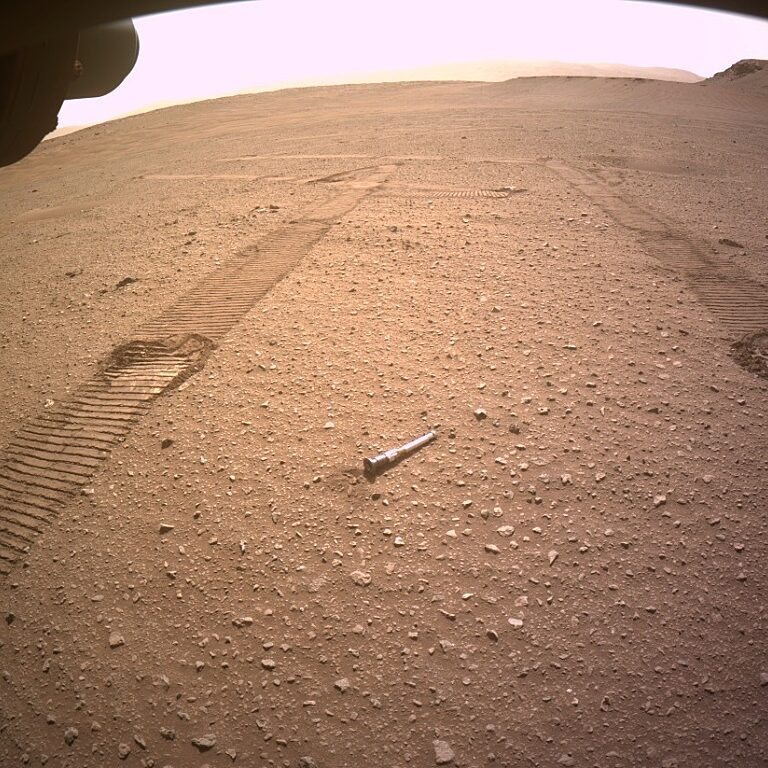Casey Dreier • Jun 27, 2023
What’s going on with Mars Sample Return?
Mars Sample Return — NASA and ESA’s ambitious project to bring Martian samples to Earth for scientific study — is in the midst of an extensive review and revision period unique among modern planetary missions. Recent updates from NASA, as well as leaked preliminary cost estimates totaling as much as $9 billion over the next ten years, suggest that the project is facing a number of technical, budgetary, and, ultimately, political challenges.
However, much is still in flux in terms of both the project's design and its final cost estimate. Mars Sample Return is undergoing an unprecedented independent engineering review prior to NASA making a commitment to the mission, and much can still change to make it a more viable (and, hopefully, affordable) project within a balanced planetary science program.

Mars Sample Return’s design is in flux
Mars Sample Return (MSR) consists of three major components: the Sample Return Lander (SRL), the Mars Ascent Vehicle (MAV), and the Earth Return Orbiter (ERO). NASA is building the first two. ESA is responsible for the orbiter (with NASA providing the sample containment system embedded within).
According to NASA project management parlance, MSR is currently in “Phase B”: detailed project design and testing. NASA and its partners are defining detailed plans, spacecraft designs, and demonstrating the viability of the technologies needed for the project.
A project’s scope and design can and does change in this period. For example, the lander design has evolved dramatically over the past two years, at one time being a very large lander with a sample fetch rover, then two landers, and now a medium-sized lander with no fetch rover and two helicopters.

Due to the complexity and cost risks associated with sample return, NASA convened an unprecedented second independent review board for the project in order to evaluate the project and assess its technological readiness. The review board is considering a range of outcomes, from full endorsement of the current design, to delaying the launch, or even total cancelation. The report and recommendations are expected in August or September of 2023.
Because of the independent review, the shifting project design, and extensive experimentation at this period of the project, there will be no official cost estimate until the project is confirmed and enters Phase C, where the design is locked and work begins in earnest to build the actual systems. At this point, cost estimates are both premature and subject to change. At a recent meeting of NASA’s Planetary Science Advisory Committee, representatives stated that MSR is undergoing multiple cost analyses, likely representing various mission concepts in various stages of design. No final cost commitments have been made.
NASA’s budgetary squeeze
Since 2014, NASA has enjoyed an unprecedented run of annual budget growth of about 4% per year, though that looks likely to end.
Congress recently passed a law that functionally freezes discretionary government spending at 2023 levels for the next two years. So although the Biden White House proposed a 7% increase to NASA next year, the space agency will have a tough time securing that from the appropriations process. Given the number of competing interests across the federal government that are fighting for the same, limited pot of funding, NASA will be fortunate merely to retain its 2023 budget next year. Inflation and supply chain issues hit NASA like everyone else, so even flat budgets act as functional cuts in the agency’s buying power.
This poses a problem, as MSR was set to grow to $949 million in 2024. But that wasn’t all: NASA’s Psyche, NEO Surveyor, Europa Clipper, and Dragonfly missions are all growing in cost at the same time, to say nothing of Artemis, Earth Science missions, and flagship missions jockeying for funding in Heliophysics and Astrophysics. VERITAS, NASA’s first mission to orbit Venus since the 1990s, already suffered a major budget cut and is now indefinitely delayed. NASA has paused new competitive planetary mission selections. There is enormous pressure on NASA’s budget, even without Mars Sample Return.
Will Mars Sample Return eat the Planetary Science Division's budget?
Early expectations were for MSR to cost in the range of $4 - $5 billion spread out over ten years. That in itself would place it among the most expensive planetary missions ever attempted (NASA’s Viking mission in the mid-1970s cost roughly $7 billion in today's dollars, and currently holds the crown for most expensive planetary science mission of all time). Cost overruns in big projects are themselves big. The fear is that if the MSR project should stumble, the consequences could easily run into the billions and consume more and more of the planetary science budget, crowding out other scientifically important mission opportunities for the next decade.
So far, that hasn’t happened. But the problem isn’t this year or even next year, it’s in the years ahead. Assuming flat funding for the Planetary Science Division over the next few years, something will have to give if MSR continues to grow, or other missions in development such as Dragonfly, Europa Clipper, and DAVINCI suffer cost growth.
| FY | PSD Total | MSR Total | % of PSD | Decadal Limit |
|---|---|---|---|---|
| 2021 | $2,700 | $23.3 | 1% | |
| 2022 | $3,120 | $653.2 | 21% | |
| 2023 | $3,200 | $822.3 | 26% | |
| 2024 | $3,383.4 | $949.3 | 28% | |
| 2025 | $3,265.8 | $700 | 21% | $1,143 |
| 2026 | $3,246.2 | $600 | 18% | $1,136 |
| 2027 | $3,350.80 | $612.10 | 18% | $1,173 |
| 2028 | $3,389.8 | $627.6 | 19% | $1,186 |
Projected MSR costs in context. All values are in millions of dollars. Note that all cost estimates beyond 2024 are considered placeholders, actuals are expected to be higher. The decadal limit is the calculated limit for how much MSR can occupy of the PSD budget per year, assuming the projected totals in the first column. Source: NASA FY 2024 President’s Budget Request.
We are already seeing consequences. In addition to the sudden delay of VERITAS, NASA has delayed the start of the next flagship mission to Uranus and the upcoming selections of its mid- and small-sized planetary mission lines. This will free up some budgetary pressure over the next few years to accommodate the slate of current programs. Additionally, Europa Clipper will launch in 2024, freeing up significant resources.
MSR has, so far, been adept at securing congressional support. Its budget has grown dramatically, but so has the overall budget for the Planetary Science Division. Roughly ⅔ of MSR costs over the past few years can be considered additive to NASA’s planetary science program. Past performance does not guarantee future results, but it is suggestive.
What the decadal survey says
The planetary science decadal survey represents the official consensus of the U.S. planetary science community and outlines their priorities for the decade of 2023 - 2032. The decadal is widely respected by policymakers, NASA, and the broad scientific community, and Congress has set into law that NASA should adhere to decadal recommendations as much as possible.
When it comes to MSR, the planetary decadal states that the project is of "fundamental strategic importance to U.S. leadership in planetary science. Its support is unequivocal: 'The highest scientific priority of NASA’s robotic exploration efforts this decade should be completion of Mars Sample Return as soon as is practicably possible.'”
Some guidelines are provided, however, to protect the overall health of the planetary science community:
“[MSR’s] cost should not be allowed to undermine the long-term programmatic balance of the planetary portfolio. If the cost of MSR increases substantially (≥20 percent [i.e. $1.06 billion]) beyond the $5.3 billion level adopted in this report or goes above ~35 percent of the Planetary Science Division budget in any given year, NASA should work with the Administration and Congress to secure a budget augmentation to ensure the success of this strategic mission.”
Notably, the decadal does not provide guidance if such budget augmentations are not secured, though nowhere does it suggest that MSR should be canceled if NASA cannot gain those funds.

What’s next?
The Independent Review Board is at work and will release its report by September of 2023. In the meantime, the project team is hard at work refining its plans, testing various technologies, and finalizing its design for major components. Assuming the independent review board recommends the continuation of the mission, MSR will enter its implementation phase later this year.
The congressional committees responsible for NASA’s budget are working on legislation to fund the agency. There is yet no indication of when this legislation will be released, but it will likely come out sometime in the summer. Despite having an overall deal on spending caps, there is still great uncertainty facing the 2024 appropriations process due to a persistent philosophical and political divide between the U.S. House and Senate on total spending amounts. Regardless, draft legislation will provide insight into congressional readiness (or weariness) for funding MSR at the requested level of $949 million next year. If MSR gets the request, even in a budget-limited situation, the question will be if the funds are reduced within planetary science or from other accounts. If it doesn't, then NASA will have to grapple with delaying the mission's launch dates, likely leading to even greater costs in the long term.
Meanwhile, Perseverance continues to collect samples of the Martian surface, diligently storing them for the future marked by uncertainty in the present.
Update: The U.S. Senate threatens to cancel Mars Sample Return
The House has yet to weigh in. And much can still happen before this threat is realized.
Support our core enterprises
Your support powers our mission to explore worlds, find life, and defend Earth. You make all the difference when you make a gift. Give today!
Donate

 Explore Worlds
Explore Worlds Find Life
Find Life Defend Earth
Defend Earth


